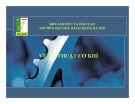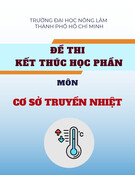
REGULAR ARTICLE
Three-component U-Pu-Th fuel for plutonium irradiation in heavy
water reactors
Ross Peel
1,*
, Luc Van Den Durpel
2
, Mark Daniel Ogden
3
, and Karl Rhys Whittle
4
1
Department of Materials Science and Engineering, University of Sheffield, Sir Robert Hadfield Building, Mappin Street,
Sheffield, S1 3JD, UK
2
Nuclear-21.net, Waasmunster, Belgium
3
University of Sheffield, Sheffield, UK
4
University of Liverpool, Liverpool, UK
Received: 6 October 2015 / Received in final form: 15 March 2016 / Accepted: 8 April 2016
Abstract. This paper discusses concepts for three-component fuel bundles containing plutonium, uranium and
thorium for use in pressurised heavy water reactors, and cases for and against implementation of such a nuclear
energy system in the United Kingdom. Heavy water reactors are used extensively in Canada, and are deploying
within India and China, whilst the UK is considering the use of heavy water reactors to manage its plutonium
inventory of 140 tonnes. The UK heavy water reactor proposal uses a mixed oxide (MOX) fuel of plutonium in
depleted uranium, within the enhanced CANDU-6 (EC-6) reactor. This work proposes an alternative
heterogeneous fuel concept based on the same reactor and CANFLEX fuel bundle, with eight large-diameter fuel
elements loaded with natural thorium oxide and 35 small-diameter fuel elements loaded with a MOX of
plutonium and reprocessed uranium stocks from UK MAGNOX and AGR reactors. Indicative neutronic
calculations suggest that such a fuel would be neutronically feasible. A similar MOX may alternatively be
fabricated from reprocessed <5% enriched light water reactor fuel, such as the fuel of the AREVA EPR reactor, to
consume newly produced plutonium from reprocessing, similar to the DUPIC (direct use of PWR fuel in
CANDU) process.
1 Introduction
The aim of this work was to perform a screening study
into alternative fuel compositions for pressurised heavy
water reactors (PHWR), which would incorporate pluto-
nium and reprocessed and/or depleted uranium alongside
thorium. The outcomes of the screening study will be used
to inform further development work into the feasibility of
such fuels.
The United Kingdom holds a large inventory of
separated plutonium. Plutonium may be used in the
manufacture of nuclear weapon fissile cores, with a critical
mass of approximately 10 kg when assembled from a
suitable isotopic mixture. When current reprocessing
contracts end in 2018, the quantity of nationally owned
separated plutonium is expected to reach 140 teHM.
The UK Government viewsthe development of a suitable
disposition strategy for this material as a high priority, partly
due to the annual cost of £80 million ($115 million) for safe
storage of the material. The plutonium has a highly variable
isotopic composition throughout the inventory due to it
having been produced from a number of reactor types with
different power and burnup histories. The material has aged
in storage for up to 60 years, during which time decay
products have built up, such as americium-241.
The UK National Nuclear Laboratory (NNL) has the
task of assessing options for plutonium disposition. They
are considering four main options [1]:
–immobilisation in a suitable engineered waste form,
followed by disposal in a mined deep geological reposi-
tory;
–production of MOX fuel for use in a suitable light water
reactor (LWR) such as the AREVA EPR, General
Electric-Hitachi Nuclear Energy ABWR, Westinghouse
AP1000 or China General Nuclear Power Company Ltd./
China National Nuclear Corporation HPR1000;
–production of a MOX fuel, with a lower plutonium
fraction than LWR MOX fuel, suitable for use in a
PHWR such as the Atomic Energy of Canada Ltd.
(AECL) EC-6;
–production of a metallic alloy fuel of plutonium, zirconium
and uranium suitable for use in the GE-Hitachi PRISM,
a liquid sodium-cooled fast reactor.
* e-mail: rpeel@sheffield.ac.uk
EPJ Nuclear Sci. Technol. 2, 29 (2016)
©R. Peel et al., published by EDP Sciences, 2016
DOI: 10.1051/epjn/2016022
Nuclear
Sciences
& Technologies
Available online at:
http://www.epj-n.org
This is an Open Access article distributed under the terms of the Creative Commons Attribution License (http://creativecommons.org/licenses/by/4.0),
which permits unrestricted use, distribution, and reproduction in any medium, provided the original work is properly cited.

The disposal option focuses on the disposal of all or the
majority of the total plutonium inventory. It is expected
that even if one or more reuse options are selected, there will
remain a requirement to dispose of at least some amount of
lower quality material directly. However, analyses carried
out by CANDU Energy have shown that all UK plutonium
is suitable for either direct use in the EC-6 reactor, or can be
blended with other plutonium stocks in the inventory to be
made suitable for reactor use [2].
As of early 2014, the preferred option of the UK
Department of Energy & Climate Change (DECC) for
plutonium disposition was reuse in a MOX fuel in LWRs
scheduled to be built in the UK in the next 10–15 years.
Previous attempts to produce MOX fuel in the UK have
had limited success. The Sellafield facility designed for the
fabrication of MOX operated from 2002–2011 with a
design capacity of 120 te/year, reduced to 72 te/year
during commissioning. However, during its first five years
of operation, the plant produced only 5.2 te of MOX fuel
[3], and produced less than 15 te over its life to 2010. It has
also been calculated that the true cost of design,
construction and operation of any replacement MOX
plant would be higher than the value of all fuel produced
by the plant [4].
The UK Nuclear Decommissioning Authority and NNL
have accepted alternative proposals from other agencies,
and three have been put forward. AREVA has proposed the
construction of a MOX fabrication plant capable of
producing mixed oxide (MOX) fuels for use in LWRs,
although currently there are no requirements for plant
operators to irradiate the resulting MOX fuel. The proposal
from GE-Hitachi Nuclear Energy considers the use of the
PRISM reactor, and the NDA have indicated “no
fundamental impediments”to the licensing of this reactor,
but are yet to declare the proposal to be credible [1]. The
AREVA and GE-Hitachi proposals have a number of
merits, but these proposals will not be discussed further in
this paper. Instead, the focus will be on the proposal from
AECL, UK CANMOX. The UK CANMOX proposal
suggests the irradiation of the plutonium inventory as part
of a MOX fuel with depleted uranium tails in a PHWR, the
EC-6 reactor. It is a complete fuel cycle proposal, including
the construction and operation of a fuel fabrication facility
and sufficient reactors to irradiate the resulting fuel, as well
as consideration given to spent fuel management.
The AECL proposal suggests the use of two MOX fuels
containing approximately 2.5 and 5% plutonium mixed
homogeneously with a depleted uranium host. These fuel
blends would be fabricated into 43-element “CANFLEX”
fuel bundles, and would be irradiated to 20,000 MWd/te
within EC-6 reactors. Thirty-five of the 43 fuel elements
would contain the MOX fuel, with the other eight
containing dysprosium oxide (Dy
2
O
3
) in depleted uranium
oxide. Dy
2
O
3
is a burnable neutron absorber, used for radial
flux flattening across the bundle. The dysprosium loading
fraction in the fuel elements is unknown. Each reactor
would consume approximately 1.3 tePu/yr from the
inventory, requiring four units running over a 30-year
lifetime to consume the UK stockpile [5]. The EC-6 reactor
has an operational design lifetime of 60 years, with a mid-
life shut down period for refurbishment of key reactor
components, notably the pressure tubes which hold the fuel
bundles and carry the pressurised heavy water coolant. It is
anticipated that following this mid-life refurbishment the
reactor would then be operated for the second 30 years of its
life with a uranic fuel. The NDA have declared the proposal
to be a “credible”option [1].
The spent fuel from UK CANMOX does still contain
significant quantities of plutonium. However, in-core
irradiation will alter the isotopic ratio to reduce the fissile
quality of the material. A burnup of approximately
20,000 MWd/te has been proposed for UK CANMOX fuel,
compared to the approximately 7000 MWd/te burnup of
natural uranium fuelled CANDU reactors, and this will
induce a significant isotopic conversion of the plutonium.
The spent fuel would not be reprocessed prior to disposal,
maximising the proliferation resistance of the material.
Spent fuel quantities from heavy water reactors are
generally much greater than those from LWRs for the
same power output due to the lower burnups achieved. A
given quantity of heavy water reactor natural uranium
spent fuel may be emplaced into a smaller volume in a
geological repository as the fuel is also less heat generating
[2]. However, this may not be the case for MOX fuels
containing significant quantities of plutonium.
As well as the plutonium inventory built up from
reprocessing activities, the UK also holds an inventory of
uranic materials, including depleted uranium tails from
enrichment activities, MAGNOX depleted uranium
(MDU) from reprocessing of MAGNOX reactor fuels,
and ThORP product uranium (TPU) from reprocessing
uranium oxide fuels from advanced gas-cooled reactors
(AGR). EDF Energy, the operator of the AGR fleet, also
owns a significant quantity of TPU. The inventory is
detailed in Table 1 [6,7]. If these inventories were to be used
in nuclear fuels the result would be to reduce the overall
quantity of natural uranium required per kilowatt-hour of
electricity generated in the UK.
Table 1. Selected data on UK uranic materials inventories as of 1st April 2013 [6,7].
Material Owner Estimated quantity/te
UF
6
tails stored at Sellafield and URENCO Capenhurst site NDA/URENCO 21,500
MDU stored at Sellafield NDA 26,000
TPU stored at Sellafield NDA 300
TPU stored at Sellafield and reactor sites EDF Energy 3110
TPU predicted future arisings to ThORP closure EDF Energy 2200
2 R. Peel et al.: EPJ Nuclear Sci. Technol. 2, 29 (2016)

The EC-6 is described as fuel flexible, and AECL have
proposed multiple alternative fuelling regimes suitable for
the reactor, including plutonium-thorium MOX fuels and
reprocessed uranium fuels [8]. There is ongoing work into
the development of natural uranium equivalent (NUE)
fuels which blend depleted and reprocessed uranium stocks
to produce a synthetic uranium oxide fuel with similar
properties to natural uranium [9].
The work described here details initial studies into
alternative two- and three-component nuclear fuel concepts
for the EC-6 reactor. Neutronic feasibility studies and
nuclear fuel materials availability assessments have been
performed into the use of U-Pu and U-Pu-Th nuclear fuels
in the EC-6 PHWR. Six uranium sources were considered:
depleted uranium tails, natural uranium, reprocessed
uranium from an EPR fuelled with enriched uranium,
reprocessed uranium from an EPR fuelled with U-Pu MOX,
MDU and TPU. Three plutonium sources were considered:
an average plutonium composition from the UK inventory,
reprocessed plutonium from an EPR fuelled with enriched
uranium and reprocessed plutonium from an EPR fuelled
with U-Pu MOX. The isotopic compositions of these
uranium and plutonium sources are listed in Table 2 [10,11]
and Table 3 [11,12]. Only natural thorium was considered,
being 100% Th-232.
The concept fuels developed for this study were based
on the CANFLEX 43-element fuel bundle, shown in
Figure 1. While these concepts include two-component
MOX fuels based on uranium and plutonium, the larger
focus is on three-component fuels which also include
thorium. Thorium is fertile, whilst uranium and plutonium
can be both fertile and fissile. In the proposed concepts
thorium oxide fuel elements would replace the burnable
neutron absorber elements from the UK CANMOX
proposal. As a fertile material thorium can become fissile
through the neutron capture process, producing additional
useable fuel material, uranium-233, after undergoing
radioactive decay through protactinium-233, which has a
half-life of 27 days. Neutron capture on Pa-233 may lead to
the production of U-232, a problematic, non-fissile nuclide,
and is to be avoided. Thorium is currently produced as an
impure by-product of the rare earth mining and purification
process from monazite ore, but is largely disposed of as a
hazardous waste material despite potential reactor fuel
applications.
CANFLEX bundles include three different fuel element
types arranged in three concentric rings surrounding a
central element [13]. The central element and inner ring of
seven elements have a diameter of 13.5 mm, and contain
fuel pellets composed of a dysprosium oxide burnable
neutron absorber in depleted uranium oxide. The 14 ele-
ments in the intermediate ring and 21 elements in the outer
ring have a diameter of 11.5 mm. In UK CANMOX fuel, the
outer ring contains approximately 2.5% Pu in depleted
uranium, while the intermediate ring contains approxi-
mately 5% Pu in depleted uranium. Such a design gives
improved flux flattening across the bundle with more
effective heat transfer to the coolant when compared to the
currently used 37-element bundle, which uses in a single fuel
element diameter [14]. Bundles are ∼500 mm long and
100 mm in diameter. The EC-6 core has 380 horizontal fuel
channels, each of which holds 12 bundles [15].
The proposed three-component fuel concepts use a
heterogeneous fuel bundle, with thorium oxide in the eight
large-diameter inner fuel elements and a uranium-plutoni-
um MOX in the 35 small-diameter outer fuel elements.
Doing so means the thorium and U-Pu MOX are physically
and chemically separated, and so minimises fuel cycle back
end processing difficulties associated with the three-
component fuel. Any back end process may begin with
Table 2. Isotopic composition of uranium sources considered [10,11].
Source Mass %
U-234 U-235 U-236 U-238
Depleted uranium 0.001 0.25 0.00 99.75
Natural uranium 0.006 0.72 0.00 99.27
UO
2
-EPR RepU 0.02 0.92 0.70 99.38
MOX-EPR RepU 0.00 0.10 0.02 99.88
MDU 0.006 0.303 0.068 99.62
TPU 0.02 0.89 0.25 98.84
Table 3. Isotopic composition of plutonium sources considered [11,12].
Source Mass %
Pu-238 Pu-239 Pu-240 Pu-241 Pu-242 Am-241
UK inventory Pu 0.21 72.0 23.7 1.55 1.08 1.51
UO
2
-EPR Pu 4.37 51.8 24.3 11.5 8.06 0.00
MOX-EPR Pu 5.90 33.3 31.3 12.4 16.8 0.00
R. Peel et al.: EPJ Nuclear Sci. Technol. 2, 29 (2016) 3

an automated disassembly of the bundles, allowing separate
treatment of U-Pu MOX and thorium oxide spent fuel
elements.
The thorium replaces the burnable absorber in the
central eight fuel elements of the UK CANMOX proposal.
As the thermal neutron flux in the centre of the bundle is
low due to the shielding provided by the MOX elements, the
capture of neutrons by Pa-233 is reduced and should allow
for a higher conversion of thorium to fissile U-233. This
separation of the fissile and fertile fuel regions is in-line with
other thorium CANFLEX concepts [16]. It is anticipated
that the neutronic coupling of thorium and plutonium will
produce some mutual self-shielding effects. Neutron
capture on both Th-232 and Pa-233 will be reduced due
to captures on Pu-240 and Am-241 present in the
plutonium. Such capture reactions will also reduce the
fission of Pu-239.
2 Neutronic analysis of fuel concepts
An empirical calculation method was developed to perform
calculations on the neutronic feasibility of the various fuel
combinations. A total of 36 fuel bundle composition
concepts were suggested, each with differing plutonium:
uranium ratios. Of these, 20 were subsequently evaluated,
as preliminary analyses indicated that reprocessed uranium
from LWR MOX fuels would perform less well than
depleted uranium tails whilst being more problematic to
fabricate due to its U-234 and U-236 content, and that the
use of natural uranium would not bring any of the desired
sustainability advantages to the fuel concept. Only one fuel
based on AGR reprocessed uranium was considered during
the early stages of the work due to the limited availability of
the material, although this was developed further in later
stages.
The common fuel for CANDU reactors is natural
uranium oxide. All fuel concepts studied in this work
are compared to natural uranium as the reference fuel.
The screening was performed by comparing the fuel
reproduction factor h, also known as the neutron yield
factor, and fission:capture ratio a
1
, of each fuel concept to
the reference fuel. The formula for reproduction factor, the
number of fast neutrons produced per thermal neutron
capture in the fuel, is given in equation (1), where nis the
average number of neutrons produced per fission in the fuel,
s
F
is the microscopic neutron cross section for fission or
absorption in the fuel as denoted by the subscript for a
respectively, Sis the sum operator, nis the total number of
fuel isotopes, iis a number representing each fuel isotope,
and Nis the number density of the isotope in the fuel
bundle.
h¼vsF
f
sF
a
¼Pn
i¼1Nivi
Pn
i¼1Ni
Pn
i¼1Nisf;i
Pn
i¼1Nisf;i
:ð1Þ
The fission:capture ratio, the overall ratio of micro-
scopic fission capture cross section to microscopic capture
cross section, is calculated using equation (2).
a1¼sF
f
sF
asF
f
¼Pn
i¼1Nisf;i
Pn
i¼1Nisa;isf;i
:ð2Þ
The calculation method used for the initial screening
study does not account for the neutronic contributions of
structural materials or the heavy water moderator and
coolant. Only fuel isotopes are considered. The results of the
calculations therefore do not give an absolute value for the
whole core multiplication factor or absolute fission:capture
ratio. Instead results for the reproduction factor are
presented as comparisons against the reference natural
uranium fuel, as well as a number of operating and proposed
fuel compositions calculated under the same method.
Structural materials and moderator are present equally
in all fuel concepts and have little effect on reproduction
factor. The fuel cladding and structural materials are
Fig. 1. Left: photograph of 43-fuel element CANFLEX fuel bundles; right: diagram showing CANFLEX fuel elements in pressure tube
(red) with annular gas space (green) contained within calandria tube (orange).
4 R. Peel et al.: EPJ Nuclear Sci. Technol. 2, 29 (2016)

largely zirconium alloys, and the moderator and coolant are
heavy water. These materials have a low capture cross
section relative to fuel materials, and so neutronic
contributions from non-fuel materials may be ignored
when using this comparative approach. This was demon-
strated and is shown below in Section 3. All calculations are
for fresh, unirradiated fuel.
The number densities of the atoms of each isotope were
calculated as follows. The total mass of each isotope of
uranium, plutonium and thorium present in the concept
fuel bundle was calculated from the geometry of the fuel
pellet stacks [9], density [17] and isotopic composition data.
Pellets were assumed to be uniform cylinders, although real
pellets have chamfered edges and dished end faces,
meaningthatthetotalmassoffuelisslightlyover-
estimated. The total volume of the outer and intermediate
ring fuel pellets was calculated to be 1500 cm
3
,whilethe
total volume of the inner ring and central fuel element
pellets was calculated to be 478.4 cm
3
,basedonthe
diameter of the pellets and the pellet stack length. The
total masses of the two fuel pellet sets were then calculated
based on the plutonium loading fraction and the theoreti-
cal densities of UO
2
,PuO
2
and ThO
2
, using an assumption
of 95% of the theoretical material density in the pellets. The
masses of elemental thorium, uranium, plutonium and
other elements were then calculated, and the isotopic
compositions in Tables 2 and 3used to calculate the mass of
each fuel isotope in the bundle.
For this screening study, it was assumed that the fuel
isotopes were homogeneously distributed through the
volume of the fuel bundle. The masses of each isotope
were used to calculate the atomic density of each isotope
across the fuel bundle total volume of 3927 cm
3
. Although
the homogeneity assumption has a significant effect on the
validity of the calculation, the results are presented only in
relative terms, and should not be used to infer absolute
performance of the fuel concepts. Thermal neutron
interaction data at 300 K from the JENDL-4.0 data library
[18] were used with the atomic densities to analytically
calculate the macroscopic cross sections for fission, capture
and scattering, and the reproduction factor hand fission:
capture ratio a
1
were evaluated. Only thermal neutron
interactions were considered, fast neutron interactions were
not included in screening the concepts. The lack of fast
neutron induced fission in the calculation meant that the
core initial reactivity would be underestimated.
3 Neutronic analysis results
Table 4 shows the results from the neutronic feasibility
assessment for the concept fuels proposed, alongside results
for a variety of more developed fuels studied under the same
method for comparison and validation. One fuel in
particular, comprising 2.5% UK inventory plutonium in
depleted uranium, was selected to represent a mimic for UK
CANMOX fuel. While this fraction is below the actual
average plutonium loading of the fuel, it also does not
account for dysprosium as the fraction is unknown.
Detailed development of UK CANMOX fuel is given below
in Figure 2 and the associated text.
The results shown are normalised to the results for
natural uranium. Values greater than unity for the
normalised reproduction factor and fission:capture ratio
are taken to indicate neutronic feasibility for the fresh
unirradiated fuel. Fuel concepts 1–9 are two-component
MOX fuels. Fuel concepts 10–18 use the same MOX
compositions as fuels 1–9 respectively, but are three-
component fuels with a thorium core region. The effect of
the addition of the thorium region can be seen by comparing
the three-component fuel of interest to the equivalent MOX
two-component fuel. Fuels 19 and 20 are additional fuel
concepts using additional uranic materials.
Two-component MOX nuclear fuels based on depleted
uranium are seen to require a minimum loading of
∼2–3 wt% Pu to be comparable with natural uranium.
Reprocessed uranium from MAGNOX reactors only
provides a minor neutronic advantage when compared
to uranium enrichment tails. In practice, this advantage
may not outweigh the difficulties introduced to fuel
fabrication when working with irradiated uranium. The
UO
2
-fuelled EPR reprocessed uranium gives a significant
neutronic benefit, allowing lower plutonium fractions
when compared to other fuels, thus maximising the
energy value of the plutonium –the quantity of electrical
energy produced per unit mass of inventory plutonium
irradiated in the core. However, studies into the effect of
burnup would be required to confirm this.
The three-component fuels 10–18 suffer significant
neutronic penalties due to the replacement of fissile MOX
by thorium when compared with their equivalent two-
component MOX fuels, and necessitate increased plutoni-
um loading to offset the use of the fertile material. At 1%
plutonium loading only fuels 16, 17 and 19 have normalised
neutronic values equal to or greater than unity, suggesting
the requirement for slightly enriched uranium. In addition,
higher plutonium fractions allow the use of lower quality
fissile uranium resources.
Some three-component fuels may be comparable with
the UK CANMOX mimic fuel. Concept fuels 16, 17, 19 and
20 have similar calculated neutronic parameters to 2.5%
plutonium loaded within a depleted uranium host, although
approximately 5% Pu would be required in the concept
fuels to match the calculated reproduction factor and
fission:capture ratio of the UK CANMOX mimic.
The calculation method used here does not allow for
accurate calculation of achievable fuel burnup in the reactor,
as the reproduction factor is only a measure of instantaneous
reactivity, which does not account for differences in the
slope of reactivity depletion caused by fuel composition
changes. As such, it was not possible to study whether the
comparatively high levels of burnup desired in the UK
CANMOX proposal are actually achievable with the
proposed fuel concepts using the calculation tools available.
Some estimates are provided for proposed fuel concepts
based on the assumption of equivalent reactivity depletion
over time. However, these are only intended to inform as to a
possible starting point for further detailed calculation
beyond the scope of this screening study.
Fuels 17 and 19 are of interest for further study. Fuel 19
should be developed further as an option for the irradiation
of the UK plutonium inventory in the EC-6 reactor, as it
R. Peel et al.: EPJ Nuclear Sci. Technol. 2, 29 (2016) 5










![Đề thi Công nghệ tạo hình dụng cụ năm 2020-2021 - Đại học Bách Khoa Hà Nội (Đề 4) [Kèm đáp án]](https://cdn.tailieu.vn/images/document/thumbnail/2023/20230130/phuong62310/135x160/3451675040869.jpg)







![Ngân hàng trắc nghiệm Kỹ thuật lạnh ứng dụng: Đề cương [chuẩn nhất]](https://cdn.tailieu.vn/images/document/thumbnail/2025/20251007/kimphuong1001/135x160/25391759827353.jpg)







